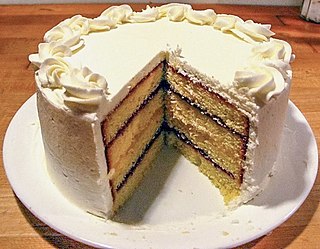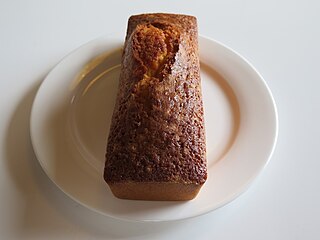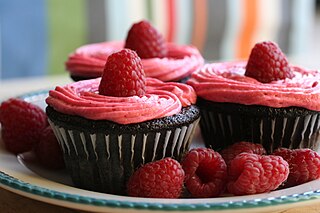
Cake is a flour confection made from flour, sugar, and other ingredients and is usually baked. In their oldest forms, cakes were modifications of bread, but cakes now cover a wide range of preparations that can be simple or elaborate and which share features with desserts such as pastries, meringues, custards, and pies.

A chocolate chip cookie is a drop cookie that features chocolate chips or chocolate morsels as its distinguishing ingredient. Chocolate chip cookies are claimed to have originated in the United States in 1938, when Ruth Graves Wakefield chopped up a Nestlé semi-sweet chocolate bar and added the chopped chocolate to a cookie recipe; however, historical recipes for grated or chopped chocolate cookies exist prior to 1938 by various other authors.

Pound cake is a type of cake traditionally made with a pound of each of four ingredients: flour, butter, eggs, and sugar. Pound cakes are generally baked in either a loaf pan or a Bundt mold. They are sometimes served either dusted with powdered sugar, lightly glazed, or with a coat of icing.

Icing, or frosting, is a sweet, often creamy glaze made of sugar with a liquid, such as water or milk, that is often enriched with ingredients like butter, egg whites, cream cheese, or flavorings. It is used to coat or decorate baked goods, such as cakes. When it is used between layers of cake it is known as a filling.

Red velvet cake is traditionally a red, crimson, or scarlet-colored layer cake, layered with ermine icing or cream cheese icing. Traditional recipes do not use food coloring, with the red color possibly due to non-Dutched, anthocyanin-rich cocoa, and possibly due to the usage of brown sugar, formerly called red sugar.

German chocolate cake, originally German's chocolate cake, is a layered chocolate cake filled and topped with a coconut-pecan frosting. Originating in the United States, it was named after English-American chocolate maker Samuel German, who developed a formulation of dark baking chocolate that came to be used in the cake recipe. Sweet baking chocolate is traditionally used for the cake's flavor, but few recipes call for it today. The filling and/or topping is a custard made with egg yolks and evaporated milk; once the custard is cooked, coconut and pecans are stirred in. Occasionally, a chocolate frosting is spread on the sides of the cake and piped around the circumference of the layers to hold in the filling. Maraschino cherries are occasionally added as a garnish.

Entenmann's is an American company that manufactures baked goods and delivers them throughout the United States to supermarkets and other retailers for public sales. Often, they are known to have display cases at the end of store aisles. The company offers dessert, cup, loaf, and crumb cakes, and donuts, cookies, pies, cereal bars, muffins, Danish pastries, and among other baked goods, buns. In the past several years, they have added designer coffee flavors along with scented candles to their product line in an effort to broaden its appeal.

Hot milk cake is a butter sponge cake from American cuisine. It can be made as a sheet cake or a layer cake, or baked in a tube pan. The hot milk and butter give the cake a distinctive fine-grained texture, similar to pound cake.

Spice cake is a type of cake that is traditionally flavored with a mixture of spices. The cake can be prepared in many varieties. Predominant flavorings include spices such as cinnamon, cloves, allspice, ginger, and nutmeg.

A butter cake is a cake in which one of the main ingredients is butter. Butter cake is baked with basic ingredients: butter, sugar, eggs, flour, and leavening agents such as baking powder or baking soda. It is considered one of the quintessential cakes in American baking. Butter cake originated from the English pound cake, which traditionally used equal amounts of butter, flour, sugar, and eggs to bake a heavy, rich cake.

Chocolate cake or chocolate gâteau is a cake flavored with melted chocolate, cocoa powder, or both. It can also have other ingredients such as fudge, vanilla creme, and other sweeteners.

A génoise, also known as Genoese cake or Genovese cake, is a French sponge cake named after the city of Genoa and associated with French cuisine. It was created by François Massialot in the late 17th century. Instead of using chemical leavening, air is suspended in the batter during mixing to provide volume.

Baking chocolate, or cooking chocolate, is chocolate intended to be used for baking and in sweet foods that may or may not be sweetened. Dark chocolate, milk chocolate, and white chocolate are produced and marketed as baking chocolate. However, lower quality baking chocolate may not be as flavorful compared to higher-quality chocolate, and may have a different mouthfeel.

Buttercream, also referred to as butter icing or butter frosting, is used for either filling, coating or decorating cakes. The main ingredients are butter and some type of sugar.

Chocolate is a food made from roasted and ground cocoa beans mixed with fat and powdered sugar to produce a solid confectionery. There are several types of chocolate, classified primarily according to the proportion of cocoa and fat content used in a particular formulation.

Dry cocoa solids are the components of cocoa beans remaining after cocoa butter, the fatty component of the bean, is extracted from chocolate liquor, roasted cocoa beans that have been ground into a liquid state. Cocoa butter is 46% to 57% of the weight of cocoa beans and gives chocolate its characteristic melting properties. Cocoa powder is the powdered form of the dry solids with a small remaining amount of cocoa butter. Untreated cocoa powder is bitter and acidic. Dutch process cocoa has been treated with an alkali to neutralize the acid.
The following outline is provided as an overview of and topical guide to chocolate:

Sponge cake is a light cake made with eggs, flour and sugar, sometimes leavened with baking powder. Some sponge cakes do not contain egg yolks, like angel food cake, but most of them do. Sponge cakes, leavened with beaten eggs, originated during the Renaissance, possibly in Spain. The sponge cake is thought to be one of the first non-yeasted cakes, and the earliest attested sponge cake recipe in English is found in a book by the British poet Gervase Markham, The English Huswife, Containing the Inward and Outward Virtues Which Ought to Be in a Complete Woman (1615). Still, the cake was much more like a cracker: thin and crispy. Sponge cakes became the cake recognised today when bakers started using beaten eggs as a rising agent in the mid-18th century. The Victorian creation of baking powder by British food manufacturer Alfred Bird in 1843 allowed the addition of butter to the traditional sponge recipe, resulting in the creation of the Victoria sponge. Cakes are available in many flavours and have many recipes as well. Sponge cakes have become snack cakes via the Twinkie.
Bumpy cake was created by Sanders Confectionery, of Detroit, Michigan, in the early 1900s and was known as "The Sanders Devil's Food Buttercream Cake" when it was first introduced. It is made of chocolate devil's food cake that is topped with rich buttercream bumps, and then draped in a chocolate ganache. Now more than a century old, this is a classic confection.

White cake is a type of cake that is made without egg yolks. White cakes were also once known as silver cakes.



















